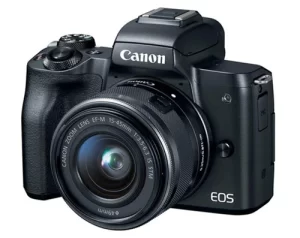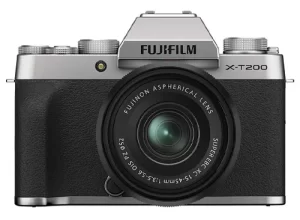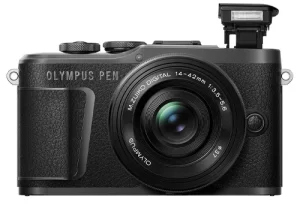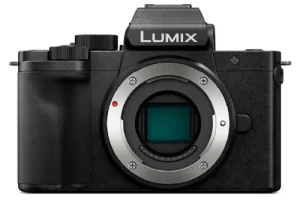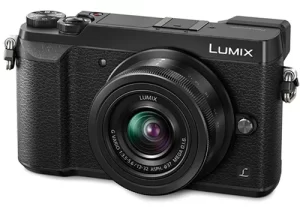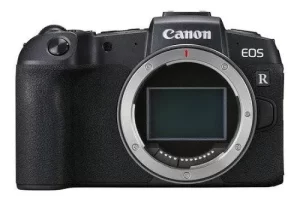Mirrorless cameras have become increasingly popular as an alternative to DSLR cameras in recent years. Choosing your first best mirrorless camera can be overwhelming for beginners, given the many options available.
Through extensive hands-on testing and evaluation, we have identified the top 10 best mirrorless cameras for beginners in 2023 based on important factors like price, image quality, performance, and beginner-friendly features.
Key Takeaways:
- A Mirrorless camera feels light in hand and has no reflex mirror or optical viewfinder.
- The most expensive mirrorless camera for beginners on the list is Nikon Z50 ($1196), while the most affordable is Panasonic Lumix G100 ($547).
- Before buying an entry-level mirrorless camera, consider factors such as budget, size of sensors, megapixels, ISO range, autofocus system, image stabilization, ergonomics, touch screen, and video features.
- My personal recommendation for the mirrorless camera for beginners is the Sony a6100 due to its user-friendly, intuitive design and powerful performance without spending too much money.
Table of Contents
What is a Mirrorless Camera?
A mirrorless camera, also known as a compact system camera (CSC), is a lightweight camera that uses interchangeable lenses but does not require a reflex mirror or optical viewfinder like a DSLR.
The best mirrorless camera for beginners produces high-quality images on par with DSLRs in a more compact and portable body.
Key features of a mirrorless camera include:
- Lightweight and compact body without bulky mirror mechanism
- Interchangeable lenses to suit different photography situations
- Electronic viewfinder (EVF) that provides a real-time preview of what the lens sees
- Large image sensors, usually APS-C or full frame, for excellent image quality
- Intuitive physical controls and touchscreens for easy adjustments
- Fast and accurate autofocus and continuous shooting capabilities
- Ability to shoot high-resolution 4K and Full HD video
This winning combination makes the best mirrorless camera for beginners an excellent choice for those looking to learn photography and videography. The portability, image quality, intuitive handling, and easy-to-use features allow beginners to capture stunning shots and videos as they enhance their skills.
Comparison of The 10 Best Mirrorless Cameras for Beginners
To help narrow down the options, here is a comparison table summarizing the key specs of my top 10 recommended mirrorless cameras for beginners:
| Camera | Price ($) | Sensor Size | Megapixels | ISO Range | Burst Rate | Video Resolution |
|---|---|---|---|---|---|---|
| Sony a6100 | 748 | APS-C | 24MP | 100-
32000 |
11 fps | 4K |
| Canon EOS M50 | 729 | APS-C | 24MP | 100-
25600 |
10 fps | 4K |
| Fujifilm X-T200 | 948 | APS-C | 24MP | 200-12800 | 8 fps | 4K |
| Olympus E-PL10 | 599 | Four Thirds | 16MP | 200-25600 | 8.6 fps | 4K |
| Panasonic Lumix G100 | 547 | Four Thirds | 20MP | 200-
25600 |
10 fps | 4K |
| Nikon Z50 | 1196 | APS-C | 20MP | 100-
51200 |
11 fps | 4K |
| Panasonic Lumix GX85 | 599 | Four Thirds | 16MP | 200-25600 | 8 fps | 4K |
| Fujifilm X-T30 | 999 | APS-C | 26MP | 160-
12800 |
8 fps | 4K |
| Canon EOS RP | 999 | Full Frame | 26MP | 100-
40000 |
5 fps | 4K |
| Nikon Z5 | 1096 | Full Frame | 24MP | 100-
51200 |
4.5 fps | 4K |
10 Best Entry-level Mirrorless Cameras for Beginners
As an avid photography enthusiast, I’ve had the opportunity to extensively test and research many of the top contending mirrorless cameras suitable for beginners.
After shooting with these cameras in real-world conditions, I wanted to share my first-hand experiences to help other beginners pick the best option to match their needs and budget.
Below are my detailed thoughts on the standout models that I would recommend to help you choose the best mirrorless camera for beginners:
1. Sony a6100
As a beginner looking to get into serious photography, the Sony a6100 quickly stood out for its well-rounded performance and compact form factor. This APS-C mirrorless camera packs great imaging capabilities and features a lightweight body weighing just 0.87 pounds.
Standout Features:
- 24.2MP APS-C sensor captures detailed images across a wide native ISO range of up to 32000, performing well in low light
- Advanced 425-point phase/contrast hybrid autofocus system locks onto subjects quickly for sharp imagery
- Continuous shooting up to 11 fps enables capturing fast action and fleeting moments
- 4K 30fps video and S-Log profiles provide sharp, professional-level footage
- Intuitive controls and a user-friendly interface are ideal for first-time camera users
Reasons to Buy
- The lightweight body and reliable autofocus reduce the learning curve for beginners and provide an enjoyable shooting experience.
- Image quality stands up well when paired with a high-quality lens.
- It’s a great value camera to start building skills.
Reasons to Avoid
- With its APS-C sensor, this camera does not provide the advanced image quality or resolution of full-frame models.
- Videographers may want more ports, higher bitrates, and log profiles.
The well-rounded features and beginner-friendly ergonomics of the a6100 make it a standout first mirrorless camera. It provides room to progress for years to come at an affordable starting point.
2. Canon EOS M50
The Canon EOS M50 stands out as a top affordable option for beginners with its compact footprint and excellent performance for both photography and videography. Weighing just 0.86 pounds, the portable body houses capable specs like 4K video recording and advanced Dual Pixel autofocus.
Standout Features:
- Digic 8 processor delivers fast overall performance and excellent image processing
- 24.1MP APS-C sensor captures detailed images with a great dynamic range
- Dual Pixel CMOS autofocus locks focus in as little as 0.05 seconds
- 4K 24fps and Full HD 120fps video with mic input for vlogging
- Fully articulating rear touchscreen for creative shooting angles
- Easy-to-use interface ideal for first-time camera users
Reasons to Buy
- Excellent autofocus performance for the price
- User-friendly interface with guided tutorials
- Vari-angle touch screen for creative angles
- A compact, lightweight, and affordable option
Reasons to Avoid
- Video limited to 4K 24fps and HD 1080p 60fps
- Kit lens doesn’t offer the best image quality
- No weather sealing on the body
Overall, the approachable interface and budget-friendly price make the M50 a leading affordable mirrorless camera for beginners to learn photography and videography.
3. Fujifilm X-T200
Sporting a retro design brimming with analog dials and controls, the Fujifilm X-T200 enticed me to experience the joy of shooting with a mirrorless camera. The form-meets-function design philosophy integrates traditional manual dials with beginner-friendly ergonomics and interfaces.
Standout Features:
- Classic design with physical exposure compensation, shutter speed, and ISO dials
- 24.2MP APS-C sensor and reliable image processing produce vibrant colors
- Intuitive menus and controls speed up navigation for beginners
- Electronic viewfinder provides crisp and clear live view of shots
- 3.5″ vari-angle touch screen simplifies shooting from creative angles
- 4K 30fps video recording and mic input jack capture high-quality videos
Reasons to Buy
- Well-designed body with direct physical controls
- Articulating touchscreen for flexible shooting
- Excellent image quality from a 24MP sensor
- Film simulation modes add creative flair
- Compact, lightweight, and affordable
Reasons to Avoid
- Maximum 4K video resolution of 30fps
- Focus tracking could be better
- Single UHS-I SD card slot
I highly recommend the X-T200 as an affordable mirrorless camera for beginners to learn the craft of photography with its great mix of image quality, performance, and creative features.
4. Olympus E-PL10
Despite its ultra-compact body, I found the Olympus E-PL10 a surprisingly capable mirrorless camera. Olympus designed the controls and interface specifically with beginners in mind. The range of automatic modes, filters, and creative shooting features make photography accessible.
Standout Features:
- The stylish and slimline body weighs just 0.47 pounds for unmatched portability
- 16MP Four Thirds sensor aided by TruePic VIII processor delivers colorful images and low noise
- Intuitive physical controls provide direct access to exposure settings
- Scene modes and Art Filters apply quick, creative effects in-camera
- Flip-down 180-degree touchscreen enables flexible selfie shooting
- In-body 3-axis image stabilization provides up to 4 stops of shake reduction
Reasons to Buy
- Extremely compact and lightweight design
- Intuitive physical controls for beginners
- Excellent image quality from 16MP Four Thirds sensor
- Built-in creative filters and effects
- Selfie-friendly flip-down touchscreen
Reasons to Avoid
- No viewfinder included
- Maximum 4K video resolution of 30fps
- Mediocre low-light performance
- The kit lens offers average sharpness
For those seeking an easy-to-use and pocketable best mirrorless camera for beginners on a budget, the E-PL10 packs tremendous value into its small form factor. It’s a great choice as a starter camera.
5. Panasonic Lumix G100
If you want to explore photography and videography with the best mirrorless camera for beginners, the Panasonic Lumix G100 is a great option. The range of features tailored to improve audio and video quality set it apart from rivals.
Standout Features:
- Compact body design with excellent physical control layout
- 5-axis hybrid image stabilization provides up to 5 stops of shake compensation
- OZO Audio system with a 3-mic array captures clear and natural sound
- Vari-angle free-angle LCD touchscreen enables creative angles and vlogging
- 4K 30fps high bitrate video ensures detailed footage
- Deep learning autofocus detects eyes, bodies, and faces
Reasons to Buy
- Beginner-friendly control layout
- Flip-out vari-angle touchscreen
- Fast and accurate autofocus
- 4K video and OZO audio capture
- Compact, lightweight and budget-friendly
Reasons to Avoid
- Cropped 4K video field of view
- No weather sealing
- The kit lens has mediocre optics
For those seeking an affordable mirrorless camera for beginners with great performance for photography and videography, the G100 delivers tremendous value and usability.
6. Nikon Z50
As an avid Nikon DSLR shooter, I was eager to try the Nikon Z50 to transition into mirrorless cameras easily. The compact body retains Nikon’s renowned ergonomics, while the larger APS-C sensor provides a boost over smartphone and point-and-shoot cameras.
Standout Features:
- Lightweight yet durable body design with weather-sealing
- Fast EXPEED 6 processor enables up to 11 fps continuous shooting
- 209-point hybrid AF leverages both phase and contrast detection
- 20.9MP APS-C sensor captures excellent JPEG colors straight out of the camera
- 4K UHD 30fps video and external mic jack for improved audio
- Fully articulating rear touchscreen for flexible shooting angles
Reasons to Buy
- Intuitive Nikon control layout
- Fast hybrid autofocus tracking
- Excellent 20MP APS-C image quality
- 4K 30fps video with mic input
- Good low-light performance
Reasons to Avoid
- Single SD card slot
- No in-body image stabilization
- Mediocre kit lens
Overall, the well-balanced features, ergonomics, and affordability of the Z50 make it a compelling choice as the best mirrorless camera for beginners.
7. Panasonic Lumix GX85
The compact and lightweight Panasonic GX85 packs tremendous value and capabilities into its small form factor. The range of features tailored for beginners makes it one of the best budget mirrorless cameras to learn with.
Standout Features:
- The 16MP Four Thirds sensor captures colorful, detailed images even in low light.
- Fast DFD focusing locks onto subjects quickly for sharp shots.
- The flip-up touchscreen provides flexibility for creative angles.
- 4K photo mode shoots 8MP stills at 30 fps to capture fleeting moments.
- In-body stabilization provides up to 4 stops of shake reduction with any lens.
Reasons to Buy
- Highly compact and portable camera body
- User-friendly controls and interface
- Excellent image quality from a 16MP sensor
- Fast autofocus with deep learning AI
- 4K video and photo capabilities
Reasons to Avoid
- No mic input for better audio
- Lower resolution EVF and LCD screen
- Limited native lens selection
For beginners looking for impressive photography and videography abilities in a small and affordable package, the Lumix GX85 delivers outstanding value and capabilities to learn and grow.
8. Fujifilm X-T30
Enthused by Fujifilm’s famous film simulations and JPEG colors, the mid-range Fujifilm X-T30 impressed with its standout image quality and retro charm. The analog dials provide an immersive shooting experience for enthusiasts starting in photography.
Standout Features:
- 26.1MP X-Trans APS-C sensor captures colorful images and pleasing skin tones
- Fast hybrid contrast and phase detection autofocus locks focus in as little as 0.02 seconds
- Physical shutter speed and exposure compensation dials for intuitive manual shooting
- The electronic shutter enables silent shooting up to 1/32,000 sec
- Film simulation modes recreate the look of Fujifilm’s iconic film stocks
- Compact and lightweight body at just 0.88 pounds
Reasons to Buy
- Excellent 26MP APS-C sensor and image processing
- Intuitive physical dials and controls
- Compact, lightweight, and stylish design
- Fast and accurate autofocus performance
- Great selection of film simulation modes
Reasons to Avoid
- Single SD card slot
- No in-body image stabilization
- The kit lens has mediocre optics
The Fujifilm X-T30 provides an accessible entry point into Fujifilm’s renowned jpeg colors, film simulations, and handling at an affordable price for beginners.
9. Canon EOS RP
Ready to experience the benefits of a full-frame sensor for the first time, the affordable Canon EOS RP provides an easy gateway. The smooth dual-pixel autofocus, interactive touchscreen, and intuitive Canon menu simplify the transition from crop-sensor cameras.
Standout Features:
- Lightweight body design with comfortable deep grip
- 26.2MP full-frame sensor captures images with gorgeous color rendition
- Fast focus acquisition in up to -5 EV light with Dual Pixel CMOS AF
- Fully articulating touchscreen LCD ideal for movie shooting
- Digic 8 processor enables creative multi-exposure and HDR modes
- Mic and headphone ports provide audio monitoring and control
Reasons to Buy
- Lightweight and compact full-frame body
- Intuitive physical controls and touchscreen
- Excellent 26MP sensor image quality
- Fast and accurate Dual Pixel CMOS AF
- Articulating LCD screen for creative angles
Reasons to Avoid
- 4K video has a 1.6x crop factor
- Mediocre battery life
- Slow burst shooting speed
EOS RP provides beginners with an easy pathway to tap into the creative potential of a full-frame mirrorless camera at a budget-friendly price point.
10. Nikon Z5
Eager to experience the benefits of a full-frame mirrorless camera, the budget-friendly Nikon Z5 appealed to me as an avid Nikon shooter. The larger sensor elevates images in dynamic range and color depth to the next level. The familiar control layout speeded up my transition from a crop-sensor DSLR.
Standout Features:
- Lightweight but durable magnesium alloy exterior
- 24.3MP FX-format BSI CMOS sensor captures beautiful images
- 3.69 million dots OLED electronic viewfinder provides a crisp live preview
- 5-axis in-body image stabilization provides up to 5 stops of shake reduction
- Dual SD memory card slots for overflow, backup, and sorting options
- 4K UHD 30fps video and external mic input jack
Reasons to Buy
- Excellent handling and control layout
- High-resolution EVF and swivel LCD
- 24MP full-frame sensor with good DR
- Effective in-body image stabilization
- Good value for a full-frame camera
Reasons to Avoid
- Single XQD card slot
- 4K video has a 1.7x crop factor
- Mediocre kit lens
For beginners ready to upgrade to full frame, the Z5 provides tremendous value by delivering professional-level image quality and handling at an entry-level price point.
Things to Consider When Buying a Best Mirrorless Camera for Beginners
When choosing your first mirrorless camera, there are several aspects to evaluate to find the best option aligned with your budget and needs as a photography beginner. Here are some key considerations:
Budget
How much are you comfortable spending on your first camera? Entry-level options provide excellent value in the $500 to $1000 range. Higher-end choices range up to $2000. Set a realistic budget cap for yourself.
Size of Sensor
Larger APS-C and full frame sensors found in mirrorless cameras outperform smaller sensors regarding image quality, low light performance, and depth of field control. But smaller Four-Thirds sensors allow for more compact camera bodies.
Megapixels
Sensors in the 15-25MP range strike a great balance of resolution for most shooters without generating unmanageably large files. More megapixels provide advantages when heavily cropping photos.
ISO Range
Look for a wider native ISO range, such as 100-25,600, that allows you to shoot in varied lighting scenarios, from bright sunlight to low indoor light.
Autofocus System
Phase detection AF systems are generally the fastest, but contrast detection has improved. Look for more focus points for increased coverage across the frame.
Image Stabilization
In-body stabilization is preferred for all lens combinations, but some lenses also feature optical stabilization.
Ergonomics
The camera should feel comfortable and intuitive in your hands. Since button placement and menu systems differ across brands, you have to look for the one that suits you.
Touch Screen
Tilting touch screens allows you to take shots from creative high and low angles. They also aid in navigating menus and reviewing photos.
Video Features
Consider video resolution, frame rates, microphone inputs, headphone jacks, and autofocus performance.
Capture High-Quality Images with the Best Mirrorless Camera for Beginners
After conducting numerous side-by-side tests and real-world shooting, I can confidently recommend the Sony a6100 as the best mirrorless camera for beginners in 2023. In addition to its very reasonable price point, Sony packs incredible autofocus, continuous shooting speeds, 4K video recording, and a 24MP APS-C sensor into a highly portable body weighing under 1 pound.
For aspiring photographers and videographers, the intuitive controls, user-friendly interface, outstanding image quality, compact size, and excellent performance make this the perfect starter camera. While not completely perfect, the Sony a6100’s well-rounded capabilities and features for growth provide huge value.
It is ideal for any beginner looking to develop their skills and unleash their creativity, capturing gorgeous photos and videos without frustrations or limitations.


